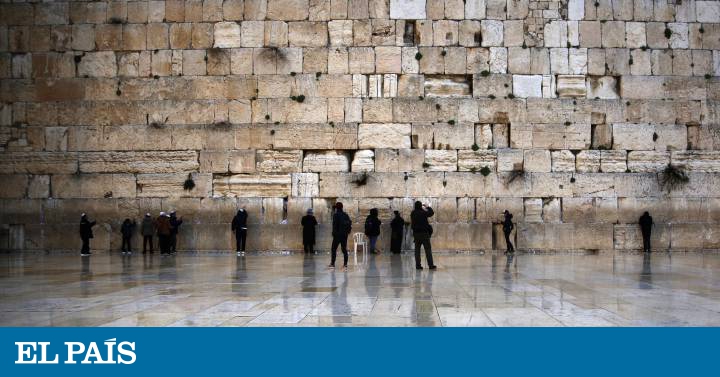1. A virtual visit: through the Old City
The Jerusalem that is worth the trip is the Old City. Origin and essence of a mestizo city that for centuries was the center of the world —and still is for many—, today converted into ground zeroof friction in the Middle East. Outside the walls there are many cities, in a religious and conservative babel, but the Holy City is behind the old crenellated doors that give way to the overlapping sanctum of the three monotheistic religions that are concentrated here. The Wailing Wall, the holiest place of worship in Judaism, is located at the south-western foot of the Temple Mount: Al Aqsa and the Dome of the Rock. It is the Noble Sanctuary for the Islamic world, third in rank after the sacred precincts of Mecca and Medina. The Jews call it, however, the Temple Mount, since they place the remains of their last Biblical temple there. The Via Dolorosa, the viacrucis of Jesus Christ traced by the Christian tradition that leads to the Basilica of the Holy Sepulcher, Golgotha and tomb of the resurrection in the same space, runs through the north end. There is a lot to see, but the walk along polished stone alleys and alleys is the best reward for the traveler who aspires to discover the surprises that the Old City holds. While we can't travel, a 15-minute YouTube video takes us through its corners: from the sunrise views from Haas Promenade to the lively streets of Jerusalem's Armenian, Jewish, Christian and Muslim neighborhoods.
2. A series: Our Boys
On Amazon or Netflix there are series that reflect the life of Jewish religious families in the Holy City, such as Srugim or Shtisel, which approaches the ultra-Orthodox world. There are also action brochures - like the famous Fauda - that stage their streets. The atmosphere of contained tension that is breathed in the Green Line that divided the city until 1967 is more evident, however, in Our Boys (HBO), which investigates the kidnapping and murder of a Palestinian teenager the day after the burial of three young men Israelis, kidnapped and killed three weeks earlier by Hamas militants, in the lead-up to the last Gaza war. The stark humanity of families' pain and the complexity of the Shin Bet (internal security service) investigations overlap the conventional narrative of an ancient conflict. Prime Minister Benjamin Netanyahu called for his boycott, considering that his plot represented a grievance to the Hebrew state. But in both the eastern (Palestinian) and western (Jewish) parts of Jerusalem the series was watched with interest despite having raised blisters on consciences.
3. A recipe: Shakshuka
In Jerusalem there are no typical dishes. Jewish chefs boast of preparing the best hummus from the Mediterranean Levante and Palestinian chefs boast that their chicken musajan is unmatched in the Middle East. Almost all the preparations are heirs to the Ottoman recipes or emerge from the kitchens of the diverse Jewish immigration. For Israelis of the Holy City, the Shakshuka of North African origin has become naturalized in the tables of local restaurants.
- 1 small onion, chopped; 1 medium red bell pepper, chopped; 6 garlic cloves, crushed
- 3 tablespoons of tomato paste (50 grams) and 800 grams of chopped tomatoes.
- 2 tablespoons of paprika; pinch of cumin; a teaspoon of salt, ½ cup of water and parsley.
- 4 eggs.
Pour a little oil into a deep frying pan over medium heat. Add the onion and fry until slightly softened. Add the red pepper and fry until smooth. Add garlic and fry until lightly browned. Add the tomato paste and brown lightly. Add the chopped tomatoes, water, paprika, cumin, and salt. Stir, cover and simmer about 10 minutes, stirring occasionally. Once the tomatoes are cooked, break the eggs over the sauce, organizing the surroundings of the sauce so that the whites are below. Cover and simmer until the yolks are cooked. Sprinkle with chopped parsley and serve immediately.
4. Typical houses: urban contradiction
The houses where the Jerolimitans have been confined during the pandemic are, in general, amorphous blocks of four heights covered by the legendary Jerusalem stone, on a uniform landscape. A clear exponent are ultra-orthodox neighborhoods like Mea Shearim. The traditional city that extended outside the walls since the end of the 19th century has been absorbed so far in the 21st century by a growing forest of apartment towers that distort the profile of the Holy City, now threatened by dozens of projects of up to 30 floors of height. Amid the confusion in which traditional towers and neighborhoods intersect, the Old City and some preserved districts survive, such as the German Colony. Many of the traditional dwellings of wealthy Arab families that marked the historical imprint of Jerusalem changed hands after the birth of the Jewish State, in 1948, and the occupation of East Jerusalem, in 1967. In the urban contradiction of Jerusalem, the rationality of the Bauhaus school, imported by Jews fled from Nazi Germany, with the anarchy of the favela neighborhoods in the eastern part of the Palestinian majority.
5. A song: Yerushalayim Shel Zahav , with a Basque air
"Jerusalem of gold, bronze and light," reads the refrain of what is considered to be the unofficial hymn of the Holy City from the Israeli point of view. The song Yerushalayim Shel Zahav (Jerusalem of Gold, in Spanish) is a tribute to the unique reflection of the sunsets on its limestone facades that alone justify the trip to the city. It is also an undeclared tribute to the golden dome of the Dome of the Rock (also known as the Dome of the Rock) as the undisputed icon of the city.
A curiosity: the melody of the famous song, composed in 1967 by the Israeli poet and singer Naomi Shemer, is inspired by the Basque-Navarrese lullaby Pello Joxepe , popularized by the singer-songwriter Paco Ibáñez, whom the author had met in a trip to Paris and he performed it in Israel during a performance in 1962. Shortly before his death, Naomi Shemer revealed to a friend in 2004 that he had been inspired by the song by Ibáñez to write the music with which she went down in history from Jerusalem.
Find inspiration for your next trips on our Facebook and Twitter and Instragram or subscribe here to El Viajero Newsletter.









